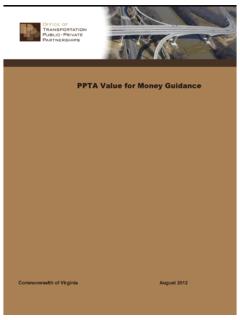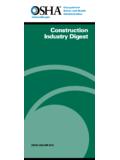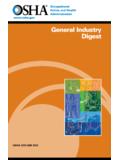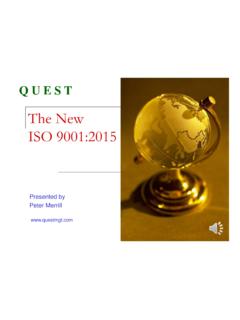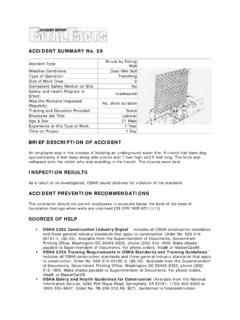Transcription of Responsible Senior Program officer: gwen Chisholm …
1 The Problem and Its SolutionThe nation s 6,000 plus transit agencies need to have access to a Program that can provide authoritatively researched, specific, limited-scope studies of legal is-sues and problems having national significance and application to their business. Some transit programs involve legal problems and issues that are not shared with other modes; as, for example, compliance with transit-equipment and operations guidelines, FTA fi-nancing initiatives, private-sector programs, and labor or environmental standards relating to transit opera-tions. Also, much of the information that is needed by transit attorneys to address legal concerns is scattered and fragmented. Consequently, it would be helpful to the transit lawyer to have well-resourced and well-documented reports on specific legal topics available to the transit legal community.
2 The Legal Research Digests (LRDs) are developed to assist transit attorneys in dealing with the myriad of initiatives and problems associated with transit start-up and operations, as well as with day-to-day legal work. The LRDs address such issues as eminent do-main, civil rights, constitutional rights, contracting, environmental concerns, labor, procurement, risk management, security, tort liability, and zoning. The transit legal research, when conducted through the TRB s legal studies process, either collects primary data that generally are not available elsewhere or per-forms analysis of existing Research DigestLegal Research Digest 39 TRansiT CoopeRaTive ReseaRCh pRogRamsponsored by the Federal Transit administrationJanuary 2012 TRanspoRTaTion ReseaRCh BoaRDOF THE NATIONAL ACADEMIESComPeTITIon RequIRemenTS of The DeSIgn/BuIlD, ConSTRuCTIon manageR aT RISk, anD PuBlIC-PRIvaTe PaRTneRShIP ConTRaCTS Seven CaSe STuDIeSThis report was prepared under TCRp project J-5, Legal aspects of Transit and intermodal Transportation programs.
3 For which the Transportation Research Board is the agency coordinating the research. The report was prepared by anthony D. songer, , Boise state University; michael J. garvin, , , virginia polytechnic institute and state University; and michael C. Loulakis, esq., Capital project strategies, LLC. James B. mcDaniel, TRB Counsel for Legal Research projects, was the principal investigator and content Senior Program officer: gwen Chisholm Smith applicationIn the recent past, the primary practice of procurement of-ficials for major transportation construction projects has been to follow the design-bid-build methodology. How-ever, increasingly this method is being criticized as restric-tive of public owner flexibility in aligning the procurement process to achieve the best value for locally funded proj-ects.
4 In response to this problem, states and local govern-ments are engaging in procurement methods that place more financial risks and liability on the contractor in the preconstruction planning process, construction manage-ment, and operational aspects of construction projects. Government procurement officers are, however, more and more resorting to alternative delivery meth-ods as a means to greater efficiency while ensuring good outcomes and value in products. This report ex-plores the use of varying systems, including design-build, construction management at risk, and a variety of options considered public-private partnerships, through the examination of seven separate construc-tion projects in various parts of the United States.
5 This examination of the seven selected projects shows how particular, and often unique, problems were met in each project by utilizing a wide variety of procure-ment and delivery methods. The results were success-ful to varying degrees; however, the intent of this re-port is not to suggest the use of one type of delivery method over another, but to demonstrate the wide va-riety of systems and procurement methods that may be available, especially as states and localities broad-en their legislative authority to enter into contracts and private-public (cont d) I. The Regulatory and Statutory Framework for Alternative Project Delivery, 3 Introduction, 3 Design-Build, 3 Construction Management, 7 Public-Private Partnerships, 8Su m ma r y, 9 II.
6 BART Extension to San Francisco International Airport, 9 Project Overview, 9 Procurement, 9 Key Contract Provisions, 10 Project Performance, 12 III. Dallas Area Rapid Transit Green Line Project, 12 Project Overview, 12 Procurement, 13 Key Contract Provisions, 16 Project Performance, 17 IV. Dulles Corridor Metrorail Project, 17 Project Overview, 17 Procurement, 17 Key Contract Provisions, 19 Project Performance, 20 V. AirTrain JFK System, 20 Project Overview, 20 Procurement, 21 Key Contract Provisions, 23 Project Performance, 24 VI. Largo Extension of Blue Line Project, 25 Project Overview, 25 Procurement, 25 Key Contract Provisions, 27 Project Performance, 29 VII. Portland Southern Corridor Portland Mall Segment, 29 Project Overview, 29 Procurement, 30 Key Contract Provisions, 32 Project Performance, 33 VIII.
7 The River Line (Southern New Jersey Light Rail Transit System), 33 Project Overview, 33 Procurement, 34 Key Contract Provisions, 35 Project Performance, 36 IX. Comparative Analysis and Discussion, 36 General Overview, 36 Procurement Processes, 39 Indeterminate Pricing, 40 Contract Provisions, 41 Legal Issues and Disputes, 41 Dispute Resolution, 42 X. Conclusion and Key Findings, 42 References, 44 Appendix A: Design-Build Legislation, 46 Appendix B: Construction Management Legislation, 49 Appendix C: PPP Legislation, 51 Acronyms, 53 CONTENTS 3 COMPETITION REQUIREMENTS OF THE DESIGN/BUILD, CONSTRUCTION MANAGER AT RISK, AND PUBLIC-PRIVATE PARTNERSHIP CONTRACTS SEVEN CASE STUDIES By Anthony D. Songer, , Boise State University; Michael J.
8 Garvin, , , Virginia Polytechnic Institute and State University; and Michael C. Loulakis, Esq., Capital Project Strategies, LLC I. THE REGULATORY AND STATUTORY FRAMEWORK FOR ALTERNATIVE PROJECT DELIVERY Introduction In the post World War II era, the delivery mecha-nisms that drove the nation's early infrastructure de-velopment lay dormant as the country's method of pro-curing infrastructure evolved to rely upon a single system, design-bid-build (DBB).1 Over roughly the last 20 years, however, many public owners have rediscov-ered the potential value of other delivery systems such as design-build (DB), construction-manager-at-risk (CMAR), and a variety of options that are considered public-private partnerships (PPP), such as design-build-operate-maintain (DBOM) and build-operate-transfer (BOT).
9 Arguments for these choices include opportuni-ties to leverage private-sector expertise and capital, to predict operational funding requirements, and to real-ize life-cycle cost reductions through the integration of delivery activities and private-sector efficiencies that are honed in competitive markets. Many within the engineering, procurement, and con-struction community in the United States have recog-nized the limitations of a strategy designed to support a single delivery method, and shifts are underway across all infrastructure sectors. Those searching for real solu-tions to their infrastructure problems have employed a variety of means to fulfill the demand for vital infra-structure services.
10 Still, public-sector experience in the use of such delivery systems remains immature, and public agencies are generally unprepared to execute workable arrangements with the private sector. Despite the recent resurgence of alternative project delivery methods, many within the construction industry con-tinue to misunderstand the characteristics and implica-tions of each system. The intent of this digest is not to provide guidance with respect to the choice of one deliv-ery method over another for transit projects. Instead, the digest primarily investigates the statutory basis for the use of alternative delivery methods and how transit agencies have legally procured and priced the services associated with alternative delivery methods.

